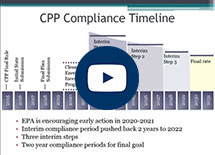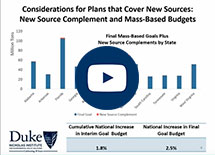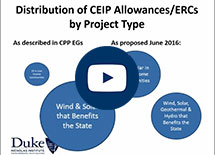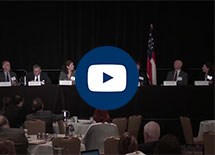On August 3, 2015, the U.S. Environmental Protection Agency (EPA) finalized carbon dioxide (CO2) emission guidelines for two categories of existing power plants under Section 111(d) of the Clean Air Act. The final rule, referred to as the Clean Power Plan, requires each state to develop its own plan that applies equivalent standards of performance to affected units. If a state fails to submit an adequate plan, the Clean Air Act authorizes the EPA to develop and implement a federal plan for the state.
Even in light of the U.S. Supreme Court’s stay of the Clean Power Plan, the Nicholas Institute continues to play a critical role supporting states and stakeholders as they navigate the resulting uncertainty.
Contents:
- Understanding the Clean Power Plan
- Proposed Rule Analysis
- Our economic modeling of the plan’s impact on states
- Power Sector Trends in the Eastern Interconnect
Understanding the Clean Power Plan
Publications
Mass-Based Trading Under the Clean Power Plan: Options for Allowance Allocation
Assuming the Clean Power Plan (CPP) survives judicial review, states may use mass-based trading programs to implement federal carbon dioxide standards for existing power plants to meet CPP requirements. A new paper describes the choices and their effects as well as explores potential goals and the allowance allocation methods best suited to achieve them.
The Clean Power Plan and Electricity Demand: Considering Load Growth in a Carbon-Constrained Economy
This policy brief discusses load growth—rising electricity demand—in the context of CPP design choices and demonstrates that it may occur under either a rate-based or mass-based approach. Following a brief overview of the Clean Power Plan and state choices, including rate-based and mass-based performance standards, it summarizes recent trends in load growth and carbon dioxide emissions in the U.S. electricity sector, showing how electricity demand growth in the United States has been low for more than a decade while the carbon intensity of electricity generation has declined.
New Sources and the Clean Power Plan: Considerations for Mass-Based Plans
The brief concludes that states may face a tradeoff in their decision to include or exclude new sources—a finding based on three factors. First, covering new sources may make it harder or easier to comply, depending on assumptions about future electricity demand and the resources that will meet that demand. Second, covering new sources would provide a consistent economic signal to existing and new sources with a similar emissions profile. In contrast, excluding new sources may lead to power market distortions. Third, covering new sources would improve the environmental integrity of the program by eliminating the risk of leakage.
The EPA's Clean Power Plan: Understanding and Evaluating the Proposed Federal Plan and Model Rules
This policy brief summarizes the final Clean Power Plan rule, describes the mass- and rate-based proposed federal plans, identifies areas in which the model rules differ, highlights key issues for states and other stakeholders as they evaluate the tradeoffs among plan pathways, and discusses the EPA’s timeline for finalizing the federal plan and model rules.
The Clean Air Act and Power Sector Carbon Standards: Basics of Section 111(d)
This policy brief offers an overview of the substantive and procedural requirements for existing-source regulations and explains the regulatory timeline outlined by the president in June 2013.
Videos
Proposed Rule Analysis
Publications
Apples and Oranges: Assessing the Stringency of EPA’s Clean Power Plan
An accurate assessment of the stringency of state emissions goals under EPA’s proposed Clean Power Plan compares state emissions goals to adjusted state emissions rates that incorporate known and reasonably foreseeable measures that will affect CO2 emissions from existing power plants. These adjusted emissions rates may include projections of actual generation and emissions, which may differ from the building block assumptions used in EPA’s Clean Power Plan. This analysis examines how consideration of these impacts can lead to a more accurate comparison of a state’s projected CO2 performance level to its final emissions goal under the Clean Power Plan and result in state plans that are optimized for the degree of required emission reduction.
The EPA’s Proposed Guidelines for Regulating Carbon Dioxide Emissions from Existing Power Plants
This policy brief provides an overview of the U.S. Environmental Protection Agency proposed guidelines under section 111(d) of the Clean Air Act for the control of carbon dioxide emissions from existing fossil fuel–fired power plants.
Preparing for CO2 Regulations for Existing Power Plants: Key Points to Look for in the Final Clean Power Plan Rule
This policy brief identifies the key elements in the final rule that could affect state implementation choices. These elements include changes in final state emissions targets, treatment of natural gas combined cycle units and under-construction nuclear units, rules and flexibility regarding rate-to-mass conversion, submission deadlines for state plans, and guidance regarding multi-state trading.
Enhancing Compliance Flexibility under the Clean Power Plan: A Common Elements Approach to Capturing Low-Cost Emissions Reductions
As states and stakeholders evaluate compliance options under the U.S. Environmental Protection Agency’s proposed Clean Power Plan, many recognize the potential economic benefits of market-based strategies. In some states, however, market approaches trigger administrative and political hurdles. This recent Nicholas Institute policy brief offers a potential compliance pathway that allows states to realize the advantages of multistate and market-based solutions without mandating either strategy.
Defining Long-Term Success of the Clean Power Plan
On August 3, the United States crossed a major threshold in the effort to mitigate climate change. With the release of the final Clean Power Plan, the nation's fleet of existing power plants now face mandatory limits on how much carbon dioxide they can emit. Jonas Monast, director of the Climate and Energy Program at the Nicholas Institute, discusses three factors for assessing the long-term success of the Clean Power Plan in The Conversation.
How Will U.S. States Shape Up to Obama's Clean Power Plan?
Environmental Economics Program director Brian Murray writes in Carbon Pulse that the final Clean Power Plan widened the door for emissions trading with five changes. But until states choose the form of compliance (rate- or mass-based) and decide whether to adopt market-ready common elements for trading across states, it will be difficult to determine the scale and scope of carbon markets.
Videos
Economic Modeling of Impacts on States
Publications
Assessing Impacts of the Clean Power Plan on Southeast States
This working paper examines how southeastern states can use the policy flexibility under the U.S. Environmental Protection Agency's proposed Clean Power Plan to choose the best and most cost-effective means of meeting their emissions goals.
The Clean Power Plan: Implications of Three Compliance Decisions for U.S. States
The proposed Clean Power Plan gives U.S. states flexibility in how they attain state-level carbon dioxide emissions rate goals from existing power plants. This analysis uses the Dynamic Integrated Economy/Energy/Emissions Model to illuminate the implications of three key decisions: whether to choose rate- or mass-based compliance, whether to pursue multistate or individual state compliance, and whether—if allowed in the final rule—to include new natural gas combined cycle (NGCC) units under the emissions limit.
Implications of Clean Air Act Section 111(d) Compliance for North Carolina
This analysis examines possible implications of meeting proposed Clean Power Plan targets in North Carolina.
Regulating Existing Power Plants under the U.S. Clean Air Act: Present and Future Consequences of Key Design Choices
This analysis explores the long-term consequences of several key regulatory design choices, including mass-based versus rate-based standards, tradable versus non-tradable standards, and differentiated versus single standards.
Videos
Power Sector Trends in the Eastern Interconnect
Experts, state officials, and stakeholders from across the Eastern Interconnect came together for a one-day workshop exploring recent modeling analyses that provide new insights into trends in the electricity sector. The event explored what these trends mean for state energy and environmental policy choices. Experts presented their findings and stakeholders had an opportunity to reflect on those insights.





















